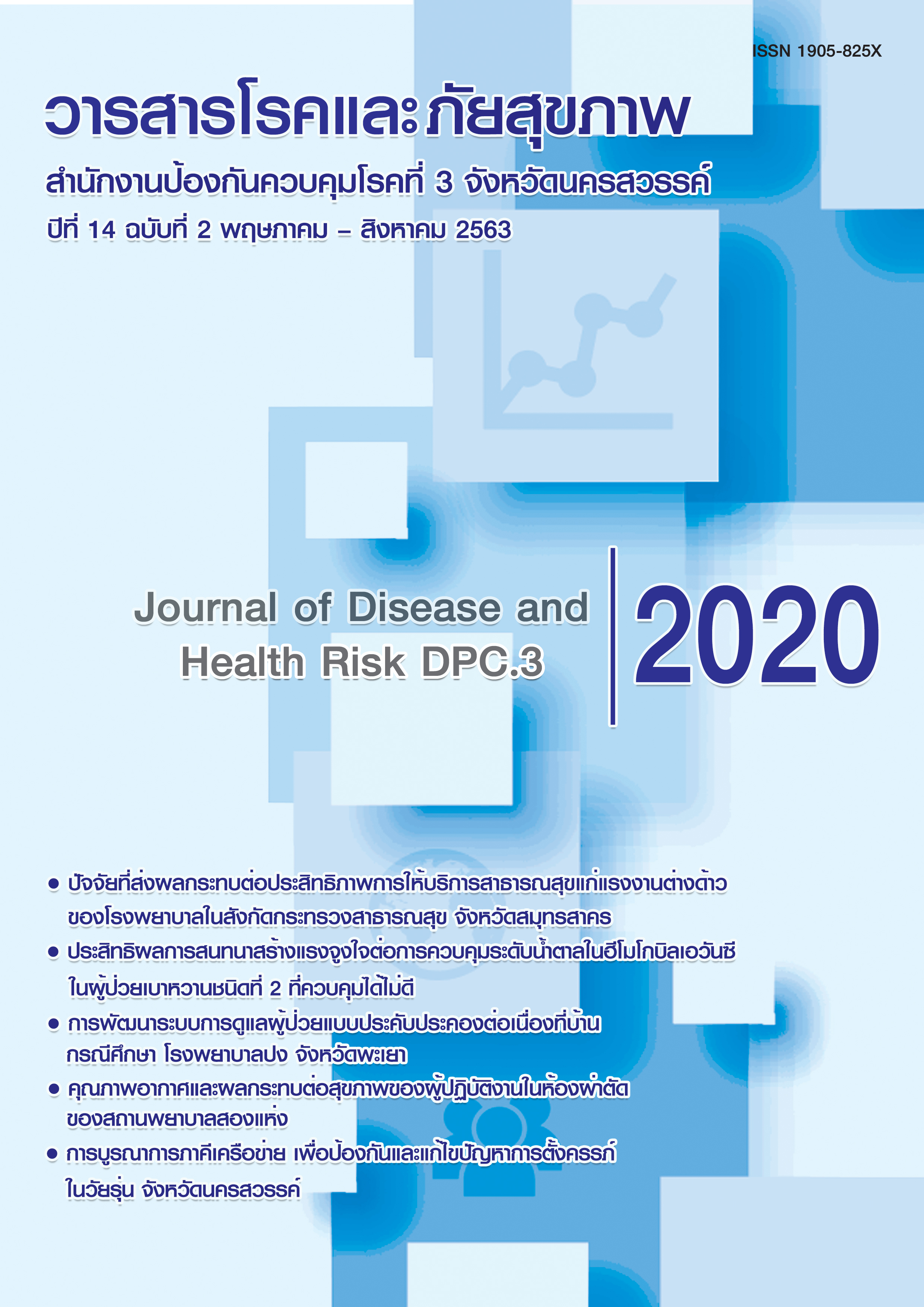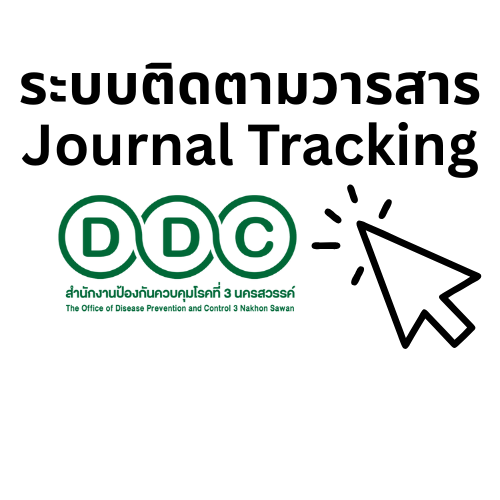The Development of Palliative Care System in Home Health Care
Keywords:
Home Health Care, Palliative CareAbstract
The purposes of this action research design. This research aimed to develop of palliative care system in home health care. This research divided into three phases. The samples were patient in palliative care clinic in Pong hospitals, selected by purposive sampling. This study used system theory as a conceptual framework, resource management concept (4M) used for analysis and develop system, and PAOR cycle used for continuous quality improvement. The data were analyzed with descriptive statistics. The findings of this study revealed that palliative care patients received continuity of care increased in phase 1-3 as 30.55, 35.48 and 73.91 percent respectively, have medical equipment support centers for palliative care patients, reduced the patients expenses, and increase hospital revenue. These findings indicate that palliative care system in home health care increase efficiency and effectiveness for patients and hospitals.
References
มูลนิธิสถาบันวิจัยและพัฒนาผู้สูงอายุไทย. สถานการณ์ผู้สูงอายุไทย 2559. กรุงเทพมหานคร: อมรินทร์ พริ้นติ้งแอนด์พลับชิง จำกัด (มหาชน); 2560.
สำนักนโยบายและยุทธศาสตร์ กระทรวงสาธารณสุข. สถิติที่สำคัญสาธารณสุข. [อินเทอร์เน็ต]. [เข้าถึงเมื่อ 24 กรกฎาคม 2562]; เข้าถึงได้จาก: http://bps.ops.moph.go.th/statistic/statisticalThailand 2011/2.2 pdf
มูลนิธิสถาบันวิจัยและพัฒนาผู้สูงอายุไทย. สถานการณ์ผู้สูงอายุไทย 2556. กรุงเทพมหานคร: อมรินทร์ พริ้นติ้งแอนด์พลับชิง จำกัด (มหาชน); 2557.
World Health Organization. Definition of palliative care [homepage on the Internet]. Geneva: The Orga-nization 2002. [Internet]. [Cited 2019 Apr 4]; Available from: http://www.who.int/cancer/palliative/defini-tion/en/
กรมการแพทย์. List disease of Palliative care and Functional unit. กรุงเทพมหานคร: อาร์ตควอลิไฟท์ จำกัด; 2559.
อรพรรณ ฟูมณีโชติ. เยี่ยมบ้านกับการดูแลผู้ป่วยประคับประคอง. สงขลานครินทร์เวชสาร. 2560; 35(4):399-406.
โรงพยาบาลปง. สรุปผลการดำเนินงานโรงพยาบาลปง ประจำปีงบประมาณ 2560. (เอกสารไม่ตีพิมพ์); 2560.
ชุติมา อรรคลีพันธ์. (2553). การสำรวจการเข้าถึงสถานพยาบาลและรายจ่ายด้านสุขภาพของผู้ป่วยที่เสียชีวิต สถาบันวิจัยระบบสาธารณสุข: 2548-2549; 2553.
กรมการแพทย์ กระทรวงสาธารณสุข. แนวทางการดูแลผู้ป่วยระยะสุดท้าย. [อินเทอร์เน็ต]. [เข้าถึงเมื่อ 24 กรกฎาคม 2562]; เข้าถึงได้จาก: https://www.skko.moph.go.th/dward/document_file/perdev/common_form_upload_file/20150316154846_2129601774.pdf2557
Mahoney, J. T. The management of resources and the resource of management. Journal of business research. 1995; 33(2), 91-101.
Kemmis, S., & McTaggart, R. The action research planner. Geelong: Deakin University Press; 1990.
World Health Organization. Pain relief and Palliative Care. In: National Cancer Control Programmes. Policies and managerial guidelines. 2nd ed. WHO Geneva. 2002; 2: 83-91.
สำนักการพยาบาล กระทรวงสาธารณสุข. ระบบบริการพยาบาลแบบประคับประคอง. ปทุมธานี: สื่อตะวัน จำกัด; 2559.
ปิยะวรรณ โภคพลากรณ์, รูปแบบการดูแลผู้ป่วยแบบประคับประคองในประเทศไทย. วารสารพยาบาลกระทรวงสาธารณสุข. 2559; 26(3), 41-51.
อัลจนา ภู่น้อย. การพยาบาลผู้ป่วยโรคหลอดเลือดสมองตีบ: กรณีศึกษา. วารสารโรคและภัยสุขภาพ สำนักงานป้องกันควบคุมโรคที่ 3. 2561; 11 (1):61-77.
ณิสาชล นาคกุล. การพัฒนารูปแบบการดูแลผู้ป่วยเรื้อรังกลุ่มติดบ้าน ติดเตียงในเขตเทศบาลนครสุราษฎร์ธานี. วารสารพยาบาลกระทรวงสาธารณสุข. 2561; 28(3):36-50.
กมลพร สกุลพงศ์, วิริยา โพธิ์ขวาง-ยุสท์ และเบญจวรรณ งามวงศ์วิวัฒน์. การพัฒนารูปแบบการดูแลแบบประคับประคองที่ใช้ชุมชนเป็นฐานสำหรับผู้ป่วยมะเร็ง: กรณีศึกษาบ้านปันรัก สุราษฎร์ธานี. วารสารพยาบาลกระทรวงสาธารณสุข. 2560; 27(ฉบับพิเศษ):90-103.
อุปทิน รุ่งอุทัยศิริ. การพัฒนาต้นแบบระบบการดูแลประคับประคองผู้ป่วยระยะสุดท้ายโดยการมีส่วนร่วมของชุมชนอำเภอเสลภูมิ จังหวัดร้อยเอ็ด. วารสารวิจัยระบบสาธารณสุข. 2551; 2(2): 1021-30.
สมจิตร ประภากร, ศุภรักษ์ มั่นน้อย,ศิริพร สวยพริ้ง,วราภรณ์ พันธุ์อร่าม และอัญชลี สุขขัง. การพัฒนาระบบบริการพยาบาลแบบประคับประคองในผู้ป่วยมะเร็งที่เข้ารับการรักษาในสถาบันมะเร็ง.วารสารกองการพยาบาล. 2558; 42(3): 50-68.37
Downloads
Published
How to Cite
Issue
Section
License
Copyright (c) 2020 Journal of Disease and Health Risk DPC.3

This work is licensed under a Creative Commons Attribution-NonCommercial-NoDerivatives 4.0 International License.
Copyright notice
Article published in the Journal of Disease and Health Risk DPC.3 Nakhon Sawan. It is considered a work of academic research and analysis as well as the personal opinion of the author. It is not the opinion of the Office of Disease Prevention and Control 3, Nakhon Sawan. Or the editorial team in any way Authors are responsible for their articles.
Privacy Policy
Name, address and e-mail address specified in the Journal of Disease and Health Risk DPC.3 Nakhon Sawan. It is used for identification purposes of the journal. And will not be used for any other purpose. Or to another person.









